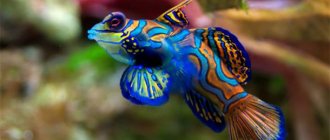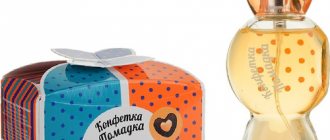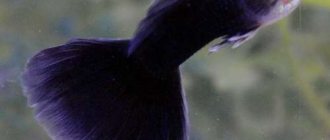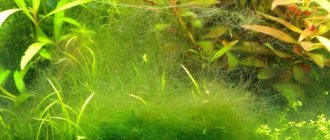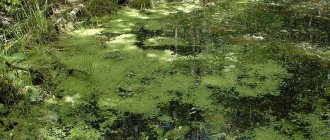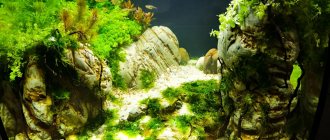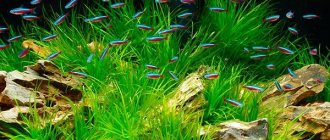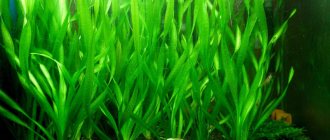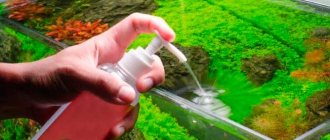It happens that aquariums are invaded by uninvited guests! And these “guests” cause great concern among aquarists, although most of them are harmless in nature. But sometimes these fears are not unfounded, since the presence of these organisms in large numbers in the aquarium is a sign of deterioration in the fish’s habitat.
In addition, this indicates the aquarist’s inattention to certain details: low-quality live food is used (which may contain these organisms), or decorative material from natural reservoirs is used that has not been properly processed.
What to do in such a situation? To get started, we recommend reading this article. This article describes in detail methods of controlling parasites. We also recommend that you consult a specialist. Read the article >>>
Such pests are unpleasant to look at and create some inconvenience. Although they do not directly harm the fish, their presence is a warning sign and should not be ignored.
Causes of nematodes
Nematodes occur both in an old tank that has been in use for a long time, and in a new, clean aquarium, even if the tank has been disinfected before use. White worms are guaranteed to appear in a pond if:
- There are food residues in the tank. When fish are overfed, excess food sinks to the bottom, where it rots and becomes a breeding ground for the development of nematodes.
- New decorative objects – carriers of larvae – are placed in the reservoir.
Types of aquarium worms
Underwater thin worms grow in the soil, decorations, glass and are divided into two types: aquarium parasites and worms that do not pose a threat. It’s easy to escape from harmless worms, but with parasites the situation is more complicated: nasty pests adapt to any conditions and lead to the death of your beloved pets. To figure out what type appears in the tank, you need to consider the common varieties:
- Planaria are serious pests that pose a threat to all inhabitants of the reservoir. Worms live in the ground, at the bottom of the container, and become noticeable in two cases: when the number has grown to colossal proportions, or if changes in water parameters have occurred. A distinctive feature of planarians is their triangular head.
- Turbellaria - refers to ciliated worms, and have a flat body surrounded by cilia. Flatworms can appear suddenly, most often on the glass of the tank or near the filter, but can settle on rocks and plants. Turbellaria are harmless to adult fish, but they pose a danger to eggs, mollusks and fry.
- Nematodes are thin worms in the aquarium that have a lifespan of a couple of days. Nematodes are food for phenotypes and are harmless, but in large numbers they spoil the appearance of the tank and the purity of the water.
- Hydras - for most aquarium inhabitants, hydras are harmless, but in rare cases this species can attack fry or eggs. It should be noted that hydras are incredibly tenacious.
To accurately determine the type of worm, experienced aquarists perform a simple trick: raise the water temperature by 2 degrees and increase the salinity. These actions will not harm pets and plants, but will bring death to nematodes. If the worms in the aquarium did not die, then another species appeared in the tank.
Ichthyophthirius
A single-celled ciliated ciliate, which lives in a weakly active form in almost every aquarium, but does not cause harm. It can settle on all types of aquarium fish without exception. Feels good at temperatures from 25 to 27 degrees .
This parasite is the causative agent of one of the most common diseases of aquarium fish - ichthyophthyriosis. The main cause of the disease is stress . During transportation, a sudden change in temperature, or prolonged exposure to water at an inappropriate temperature, the parasite becomes active. At the same time, characteristic symptoms can be observed in the fish - loss of appetite, lethargy and the “semolina” itself - small white dots, pustules, which are a kind of “house” for the parasite.
It is advisable to begin treatment of ichthyophthyriosis as early as possible, since in the last stages of the disease the ciliates infect the gills, which leads to the inevitable death of the fish. First, be sure to raise the water temperature in the aquarium to 32 degrees . This is done in order to disrupt comfortable conditions for the parasite. The next stage is the destruction of ichthyophthirius by adding salt to the water or by introducing specialized medications.
Adding salt to the water is done at the rate of 1 tbsp. spoon for 10 l. water . Regular table salt will also work for this purpose, although it is better to use sea salt.
Diplomonas
A parasite that belongs to flagellates . It primarily affects the intestines and pancreas of fish. The water temperature, comfortable for the life of diplomonas, is up to 30 degrees. The presence of this species of flagellate in an aquarium can provoke a fairly common disease - hexamitosis. Cichlids and labyrinths are most susceptible to this disease.
A healthy fish can “pick up” this parasite from an infected fish, as well as from plants and even water from a diseased aquarium. The main symptoms of hexamitosis include complete or partial refusal to eat, whitish tint and mucousness of feces, the formation of wounds and ulcers on the head and sides, and the appearance of holes on the body of the fish. This is where the name common among amateur aquarists comes from - hole disease.
To treat hexamitosis, it is advisable to place fish with obvious signs of the disease in a separate tank and treat them with specialized drugs. In a general aquarium, it is imperative to carry out preventive measures. To do this, it is advisable to increase the water temperature to 33 - 35 degrees and introduce special medicinal feed into the diet.
Worms (worms)
Various helminths enter the fish’s body from external sources (food, plants, soil). Some worms in aquarium fish cause serious diseases and threaten the lives of pets.
Caryophylllosis
The causative agent is the tapeworm Caryophyllaeus (or carnation). Its undivided body, up to 40 mm long, has a fan-shaped corolla in the head. The larvae of these worms form in tubifex tubes, which, when eaten, infect the fish in the aquarium. In their intestines, oviparous sexually mature individuals are formed, parasitizing for up to 1 year. Consequences of caryophylllosis:
- exhaustion, pain;
- rupture of the intestinal wall, peritoneum;
- fish fatality.
The main symptom of caryophylllosis is an unnatural protrusion of the abdomen. Mostly thin worms, like worms, settle in the intestines of poeciliids - swordtails, guppies, mollies, as well as barbs and goldfish. The following drugs are used for treatment:
- Kamal – up to 0.01 g twice a day, every other day;
- fenasal, divermin - up to 1% of the feed weight;
- cinrinocystin – food with 1% phenasal.
Worms in fish
Sanguinecolosis
The disease is initiated when worms of the genus Sanguinicola appear in fish. These flat helminths have a lance-shaped body, translucent, with a whitish tint and tiny bristles. The length of their microscopic body reaches up to 1 mm. The larvae mature in mollusks - pond snails that have swallowed the eggs of the parasite.
A sexually mature specimen is formed in the blood vessels of the fish, destroying the walls of arteries and soft tissues of internal organs. Obstruction of the gill vessels, fungal infection of the fish (saprolegniosis), attacks of suffocation, and bilateral bulging eyes are observed. For the treatment and prevention of sanguinecolosis, baths with table salt (2-3% solution for 8-10 minutes for 3-4 days), 3% hydrogen peroxide (70 ml per 1 liter of water, 15 minutes for 2-3 days) are used. .
Argulus
A small blood-sucking parasite, which is a gill-tailed crustacean with developed swimming legs, which allows it to move freely from one fish to another. Reaches a size from 2 to 12 mm , so it is visible to the naked eye. The most favorable temperature for the development of argulus is 25 - 28 degrees, but the viability of the parasite does not decrease even at 10 degrees.
It parasitizes mainly cyprinids. Basically, fish louse gets into the aquarium when feeding with live food or when introducing wild fish. The main symptoms of argulosis are refusal to eat, anxiety, and the appearance of ulcers and wounds at the sites where the louse has pierced the louse. The affected fish rubs its sides against decorations and plants, lags behind in development, and becomes skinny. As a result of constant bites, the fish dies over time.
To treat argulosis, fish are caught from the aquarium and a complete water change is carried out, as well as the soil and decorations are cleaned. This is done in order to destroy eggs and individuals not attached to the fish. Next, the attached parasites are removed from the affected fish with tweezers and lotions are made with potassium permanganate. To prevent argullosis, it is necessary to limit feeding with live food and exclude wild fish from entering the aquarium.
Uninvited guests in the aquarium. Let's get to know each other better!
It happens that aquariums are invaded by uninvited guests! And these “guests” cause great concern among aquarists, although most of them are harmless in nature. But sometimes these fears are not unfounded, since the presence of these organisms in large numbers in the aquarium is a sign of deterioration in the fish’s habitat. In addition, this indicates the aquarist’s inattention to certain details: low-quality live food is used (which may contain these organisms), or decorative material from natural reservoirs is used that has not been properly processed.
Such pests are unpleasant to look at and create some inconvenience. Although they do not directly harm the fish, their presence is a warning sign and should not be ignored. Copepods
Copepods are small aquatic crustaceans. Most of them are harmless to fish. Some free-living species, such as Cyclops , are used as live food. At the same time, representatives of some species of copepods are parasitic on fish.
Free-living, harmless copepods are usually translucent and reach a length of 3 mm. They move in short leaps, but can also lie on underwater surfaces, including on the glass of an aquarium, where they are brought either intentionally (as live food) or accidentally (with live plants). Few manage to survive in an aquarium for a long time - for most fish this is a real delicacy. True, large fish do not pay attention to them, because they are too small.
Thus, contamination of an aquarium with free-living copepods can only occur if the fish find them unsuitable food, or because the fish are so unwell that they have lost interest even in such a tempting food source. This may be due to environmental pollution (heavy organic load). If copepods begin to reproduce in the aquarium, it means there is organic pollution. If you eliminate the problem that caused this behavior of the fish, then your aquarium inhabitants will be very happy to solve it themselves. Water donkey
Water lice (Asellus aquaticus) are a species of freshwater crustaceans from the order of isopods, also called water lice . They bear some resemblance to woodlice, of which they are relatives. They can be brought into the aquarium along with live, unfrozen food (or as live food). They inhabit inaccessible crevices in decorative objects, as well as the filter. They do not cause direct harm to fish, but can play the role of intermediate hosts for acanthocephalus (spiny-headed worms). These worms rarely infect aquarium fish, so there is no need to worry too much about this. However, a large population of aquatic burros indicates that there is heavy organic pollution in the aquarium, to which these creatures contribute further. Hydras
These small coelenterate invertebrates are freshwater relatives of sea anemones. They can be from 2 mm to 2 cm in length (including tentacles). They have the shape of a stem, topped at one end with tentacles, while the other end is attached to a solid base. All these signs make it possible to unmistakably recognize them. However, sometimes they shrink into tiny jelly-like balls. The color can vary from cream to gray or light brown, sometimes taking on a pleasant greenish tint.
Hydra is a true predator. She is insatiable and feeds constantly. Long tentacles armed with special stinging capsules. A mouth that stretches so that it can swallow prey much larger than the hydra itself in size. Eats countless amounts of prey, the weight of which exceeds its own. Hydras are safe for adult fish, but they can catch fry and other small fish, as well as small particles of fish food. Dangerous for young shrimp. Sometimes their numbers reach such a level that they become real pests.
Some species of fish feed on hydras (especially gourami, as well as young cichlids “grazing” on the rocks). Therefore, they can be used to control the hydra population, but only if these fish are suitable inhabitants for the aquarium in question.
Roundworms (nematodes)
They are a large group of threadworms, also called roundworms. Among them there are both free-living and parasitic species. Non-parasitic nematodes are small viviparous worms with a body length of 1–3 mm. Sometimes they colonize the substrate and biological filter. They can be brought into the aquarium along with live, unprocessed food, but they are completely harmless. If their population becomes too numerous, this indicates that adjustments are needed in aquarium hygiene and fish feeding regimen. These improvements are the only thing needed to reduce nematode numbers. Oligochaete worms
These are annelids from the family Naididae , reaching a length of 2 cm. They are characterized by the presence of bristles (perhaps thanks to them they are inedible for fish). Most often these are white or pink worms that reproduce by budding or laying eggs. They can be brought into the aquarium along with plants, in the shells of aquatic snails, or in water in which live food caught in the wild has been carried. In an aquarium, they can live in the soil layer or on its surface, feeding on detritus. Therefore, their presence in significant quantities is an indicator of poor aquarium hygiene and the danger to which the fish are exposed due to contamination. These worms themselves are harmless. Improving aquarium hygiene will bring their numbers under control and will benefit the fish by improving living conditions.
Planaria
Planaria are flatworms with hair in the form of small cilia. They often strike fear into the hearts of aquarists, as they are mistakenly mistaken for parasites like leeches. Aquarium planaria typically range in length from 2 to 10 mm and are creamy white (Dendrocoelum lacteum) , gray (Planaria lugubris) or brown (Planaria torva) . Light planaria appear translucent when placed on the glass of an aquarium, while dark planaria look like tiny slugs. Common characteristic features are a V-shaped head and a slow gliding motion along the surfaces of the aquarium.
Planaria can be unintentionally introduced into the aquarium along with aquatic plants, untreated soil or live untreated food. In an aquarium there can be a small and completely invisible population of planaria, since they lead a predominantly nocturnal lifestyle, hiding in the ground, among plants or under decoration. Therefore, it is difficult to notice them, especially if they are dark planarian species. Creamy whites are quicker to recognize their color. Sometimes their numbers become too large, and then you can see them crawling along the front glass of the aquarium or swimming freely in the water. Such rapid reproduction is an indicator of overfeeding of fish. Uneaten food is consumed by planarians, whose population grows at an explosive rate. Some fish species, such as macropods, bettas, and gourami, eat planarians and thereby control their numbers.
Planaria are dangerous because they eat shrimp eggs, young and small fish species, and some snails. They can also harm adult shrimp and crayfish. Shelly crustaceans
Shelly crustaceans (Ostracoda) are bean-shaped crustaceans that reach a length of 4 mm. Sometimes you can see them scurrying around on the substrate, like tiny moving specks. These creatures are yellowish or black-brown in color. They attach their eggs to plants, so they can be accidentally introduced into the aquarium along with new live bushes. In aquariums, they are usually found in small numbers, but if hygiene leaves much to be desired, they can begin to multiply rapidly and become a real disaster. Thus, although barnacles are harmless, their presence indicates an environmental or nutritional problem with the fish. Improving aquarium care is a simultaneous solution to both problems. It allows you to control the number of these animals and eliminate the causes of their rapid reproduction. Snails
Some aquarists deliberately introduce aquatic snails into the aquarium so that they serve as “cleaners” and clean up leftover food. Sometimes snails get into the aquarium by accident - usually on plants. But no matter how the snails got into the aquarium, if they later turn out to be unwanted, removing them from there is not at all easy. This is especially true for the viviparous snail called Melania tuberculata . These snails live in the ground, where they can reproduce very intensively, and in such a way that the aquarist will have no idea that they are there.
The presence of a large number of snails is an indicator of an unhealthy aquarium. For snails to live, they must not only find enough organic matter to feed on, but also consume oxygen and produce organic waste. Some of them eat fish eggs. Snails caught in the wild or in ornamental ponds can introduce a variety of parasites into the aquarium, for which they act as intermediate hosts.
Snail populations can be kept within reasonable limits by regularly removing all snails that can be seen. For example, you can collect them with a net or using a siphon. Large specimens can be caught individually by hand. It is better to remove snails after turning off the lights in the aquarium, since most of them are active at night.
To avoid accidentally introducing snails, it is perfectly acceptable to treat the plants with a shellfish killer before planting them in the aquarium. Remember that when you visually check your plants, tiny snails or eggs may not be noticed. Source: “The Aquarist's Golden Book” by M. Bailey, P. Burgress
Planaria
A real scourge for the aquarist. It is a flat worm covered with cilia, up to 1 cm long. It lives throughout the entire water column, actively breeds, laying eggs on plant leaves. Eats fish and shrimp eggs, attacks snails and fry. This parasite also likes to get into the gills, which eventually leads to the death of the fish. Planaria is clearly visible in the aquarium, although it “operates” mainly at night.
It gets into the aquarium with plants, soil, and when fed with live food. To destroy the parasite, it is necessary to raise the water temperature to 33 degrees and subsequently do a complete water change with thorough cleaning of the soil. There are also chemicals available to combat planaria. There is another option - add gourami to the aquarium, which will gladly eat the parasites.
Milk planaria
Planaria - uninvited guests in the home aquarium Planaria are an unpleasant guest in both marine and freshwater aquariums. This species has many subspecies, among which there are very harmful representatives. If you notice a worm in an aquarium, you should take appropriate measures, otherwise milk planarians can cause serious damage to fish and crustaceans.
Planarians
Characteristics of the parasite
White planaria belongs to the class of parasites. The appearance of the worm has characteristic features. A distinctive feature of planaria is the triangular shape of its head. The parasite has an elongated body structure, the size of which reaches 1 cm. Therefore, they can be seen visually. As a defense, planaria secrete a bitter mucus that repels predators. There are a large number of cilia on the surface of the body, which help the parasite move. Planaria have two eyes, and their color can vary significantly from dark colors to light shades. The most common representatives of home aquariums are white and brown planaria. Parasites are nocturnal, but can appear on the surface of the aquarium even during daylight hours. As a rule, worms hide among algae.
Distinctive features of the species
Worms are hermaphrodites. They are capable of multiplying to a huge scale even in a short time. At the same time, milk planaria has amazing regeneration. Even decapitated individuals are capable of continuing to exist. Damaged organs grow back in a short time. After a couple of weeks, the parasite can fill the entire aquarium.
How do planaria threaten aquarium inhabitants?
Planaria in an aquarium can cause a lot of trouble. Parasites primarily threaten shrimp. They destroy the entire population. The main prey of planaria are female shrimp. Parasites can cause fatal damage to crustaceans and snails. In most cases, worms cause the death of fish. They are able to penetrate the gills and feed on live fish, literally tearing out pieces of flesh. The fish begin to get sick, many die from suffocation. The main sign of the presence of parasites in an aquarium is the restless behavior of the fish, when they jerk their heads from side to side and rub against the ground. White planaria has no natural enemies in the aquarium. Even large fish do not eat worms, since their skin is covered with bitter mucus.
How do parasites get into an aquarium?
As a rule, worms enter the home aquarium from external sources. Often aquarists do not treat the soil with special solutions before placing it on the bottom of the reservoir. Worm eggs can be found on aquarium plants, which also require special treatment. The appearance of planaria can also be caused by live food.
Planarians
The main factor in the reproduction of the parasite is the abundant amount of food that falls to the bottom. This occurs due to overfeeding of fish. When large individuals do not eat all the food, small remains sink to the bottom. To avoid such a situation, it is necessary to create a special diet for the fish. Or get those aquarium inhabitants who love to surf the bottom in search of food.
How to remove parasites
The most effective measure to rid an aquarium of parasites without harming the fish is mechanical extraction of worms using a sap. However, it is impossible to catch absolutely all representatives. Fighting methods:
- increase in water temperature - most parasites cannot tolerate hot temperatures of 35 degrees. However, this method can affect other inhabitants of the aquarium in the same way. Therefore, before carrying out the procedure, it is necessary to remove fish and invertebrates from the reservoir;
- traps - worms have a developed sense of smell; they sense prey at a great distance. In this case, this is their weakness. Aquarium owners need to fill a gauze bag with beef, tie it, fasten it with a rope and lower it to the bottom. After an hour, the planarians will surround the bag, trying to eat the victim. They can be caught by sap;
- electric discharge of water - with preliminary movement of the fish to another container;
- hunting for planaria - some aquarium inhabitants are capable of completely destroying worms. Hungry chromis, cockerels, gurams, cichlazomas do an excellent job with the task;
- The most comfortable method of elimination is the use of drugs that include fenbendazole. Planaria react sharply to it and die, while the substance does not harm crustaceans and fish;
- total measures - if other methods of breeding did not help, and the white planaria remained in the aquarium, then the container must be reinstalled. The soil must be boiled. Algae and decor should be completely changed or disinfected.
aquarists.ru>
Hydra
A parasite that belongs to a separate genus and class. In appearance it is a small (up to 3 cm) translucent tube with tentacles. Once in the aquarium, the hydra attaches itself to plants, rocks or decorations and begins to hunt, spreading its tentacles. It feeds on any small living creature and is mainly whitebait. The peculiarity of the hydra is its ability to “consume” a creature three times its size.
It is quite unpretentious and reproduces very quickly. It enters the aquarium with live food or a plant taken from the wild. You can remove hydra from the aquarium mechanically by introducing a gourami or macropod into the aquarium. Also, to destroy hydra, you can use chemicals, do a complete water change, while washing the plants with a weak solution of potassium permanganate and scalding the soil with boiling water.
Types of otocinclus
There are about 30 species of catfish . There are no fundamental differences between the varieties; the color of the otocinclus differs mainly, and the body sizes differ somewhat.
Most often in aquariums you can find the following representatives of the genus:
Otocinclus affinis
It is distinguished by its small size (up to 5 cm) and nondescript color in white and gold tones. There is a wide dark stripe along the back, which ends in a rounded spot.
Otocinclus negros
It lives in the river of the same name in Paraguay. The size of the catfish is small, only about 3 cm. The color varies from gray to brown, which allows the catfish to camouflage perfectly in the shade of plants and snags.
Otocinclus broadstriped
The size of an adult is from 3 to 4 cm. The color is gray-green or gray-brown with a silver-white belly. A wide dark stripe runs along the entire body, which became the basis for the name otocinclus.
Turbellaria
A small white ciliated worm that settles on the walls of the aquarium, soil, plants and decorations. Clearly visible to the naked eye. Basically it does not harm the fish, however, in some cases it can attack eggs. Also, this parasite can harm snails, and some forms even fry.
Turbellaria appears as a result of poor aquarium care, when there is overfeeding and water changes and soil cleaning are rarely done. In order to get rid of worms in an aquarium, simply do a complete water change, thoroughly rinse the plants and scald the entire underwater interior with boiling water. It is also important to dry the decorations and soil well in order to get rid of the parasite eggs.
Nematodes
Small worms, white in color, about 2 mm in size, there are several tens of thousands of their varieties. They are practically safe for aquarium inhabitants; many of them use nematodes for food. Formed as a result of an abundant amount of food, it can appear from contaminated objects brought into the aquarium (decorations, filters, soil). To get rid of it, the temperature of the liquid is raised to 35-42 degrees, increasing the level of salt in the aquatic environment.
Any parasites that appear in the aquarium are unpleasant guests and you should not wait for them to completely take over the habitat; you must immediately begin the fight. Pay great attention to preventive measures: choose high-quality and proven food, keep the water clean, promptly remove food debris, and before adding soil and decorations, use various measures to clean and disinfect them.
Parasitic plants
In addition to various living organisms, plant parasites also seriously bother aquarists. In total, there are 4 types of such uninvited guests in the aquarium and the methods of dealing with them vary slightly.
It is important to know! When destroying algae using specialized preparations, you need to make sure that they are safe for aquarium plants. If the medicine can harm them, the plants are replanted while the drug is being used.
Green algae
Externally, these are short or long green threads, small spots on decorations and plants, a green “carpet” on the walls of the aquarium. It appears in the aquarium due to overfeeding and insufficient hygiene, or it is introduced with new fish and plants.
Fighting green algae is very difficult; the process itself includes a set of measures.
- Mechanical cleaning using a scraper, sponge, etc.
- Control of cleanliness in the aquarium. Regular changes of a quarter of the total volume of water, cleaning the soil using a siphon, proper feeding, no frills.
- Use of specialized drugs.
- If possible, you can add fish such as Gerinocheilus, Ancistrus, Otocinclus or several ampularia snails to the aquarium, which will happily eat green algae.
By regularly keeping your aquarium clean and rinsing plants from outside sources before planting, you can minimize the risk of green algae entering your aquarium.
Red algae
Most algae of this species live in seawater. In freshwater aquariums there are varieties that are called “beard” by aquarists and are classified as filamentous. They settle mainly on the tips of the leaves of cultivated plants or on the ledges of stones and snags.
The most common red algae in a freshwater aquarium are flip flop and beard algae. The first becomes bushy as it grows, while the second consists of separate long threads. Both parasites are dark green to black in color. They reproduce very quickly and are very unpretentious to the environment, so it is extremely difficult to get rid of them. The following methods of combating red algae have proven themselves well:
- Mechanical cleaning . Glass, decorations and soil are thoroughly cleaned. It is advisable to remove plants on which the parasite has settled from the aquarium. Make water changes once a week for a third of the total volume.
- Biological cleaning . In this case, algae eaters such as Gerinocheilus, Ancistrus or Labeo are added to the aquarium.
- Removing the parasite by introducing specialized drugs.
- If we are talking about a “flip-flop”, there is a way to clean the aquarium in the shortest possible time. To do this, you need to add coal dust to the water, stirring until the powder completely settles. The disadvantage of this method is the need to remove the fish during treatment.
For prevention purposes, it is necessary to monitor the amount of organic matter in the aquarium and not overfeed the fish.
Dangerous planaria - causes of infection
Planaria, or planarians (lat. Planariidae) is a family of flatworms, belong to the class Ciliated worms. Ciliated worms have three body layers: ectoderm, endoderm and mesoderm. Planaria leads a parasitic existence in a body of water, therefore, if it appears in a home aquarium, it can pose a threat. The length of the worm reaches 15-40 cm in length; it can easily fit into a human palm. There are freshwater, marine, and terrestrial planarians whose diet consists of small invertebrates. Their glands contain poison, which is why many fish do not eat these worms. However, young gouramis and cockerels can feast on them.
The appearance of worms in a home aquarium
The types of planaria in the aquarium can be found as follows: mourning, brown and milky white. They live in the soil layer, on vegetation, sometimes crawl out and sit on the walls of the tank. Finding planaria in an aquarium is very difficult because of their color; it is easier to find white ones than brown ones.
How is planaria harmful in a closed aquatic system? This worm can feed on shrimp eggs, settling in the spawning tank, it can reduce the number of eggs, and eat crustaceans and their food. Planaria can also harm mature shrimp by settling under their shell, clogging their gill covers. As a result, the shrimp may suffocate and die, or the planaria may eat the injured shrimp. In addition to physical harm to living creatures, planaria make the walls of the tank unsightly - they are visible both day and night.
Look at the planaria on the wall of the aquarium.
The first question for aquarists who notice these worms is: “Where can they come from?” Under proper tank care conditions, they are unlikely to appear, but there are a number of reasons that can trigger their growth:
- Planaria are brought into the water along with the soil;
- They can live on sick fish, crustaceans and shrimp, on plants that have been added to the aquarium;
- The worms were brought into the interior of the aquascape along with decorations from the old tank.
If planarian worms are introduced into an aquarium, they will begin to multiply rapidly; favorable conditions for them are changes in temperature conditions and irregular cleaning of the water space.
What to do to remove eyelash worms
Planarians can self-reproduce - this means that fragments of their body later form new worms, ready for a full life. That is, if it loses its head or tail, it will grow back. Planaria is a very tenacious creature, but it can be removed from the aquatic environment using effective methods.
- One of the easiest ways to combat worms is to introduce fish that feed on them (iris melanotenia precox, young gourami).
- An effective method for removing pests is to set a trap.
For bait, you can take gauze with protein food (beef, squid) and put such a bag on the bottom of the nursery. In the morning you need to collect the trap along with the pests and boil them in boiling water. However, the procedure must be repeated many times, which will require patience. Watch a video detailing planaria and how to combat them. - Additives containing chemical components may work faster. Fenbendazole, which can be included in some products, is effectively used: Flubenol, Flubendazole. The active substance is harmless to permanent residents of the reservoir, but destroys planaria. Required dose: 0.2-0.4 grams per 100 liters of water. After a day, you can notice the first improvements - there will be fewer parasites. It is recommended to use fenbendazole in suspension form, since the powder does not dissolve well.
- Table salt in proportions of 1 gram per liter of water effectively copes with the parasite. However, it should be noted that salt is harmful for some plants and fish, so temporarily transfer them to the nursery.
- Table vinegar successfully fights planaria - a dose of 0.5% or 0.25% solution. A high concentration of vinegar will kill worms faster, but a more gentle solution can be used. After using salt or vinegar baths, you should rinse all treated items in boiled water so that the remaining liquid does not harm fish, plants and shrimp. You can purify the water mechanically using a filter, or by changing the water.
- Also, to remove unwanted “guests” in the aquarium, you can use various pesticides by heating the water to a temperature of 28-30 degrees Celsius. You can apply a current charge through water (12 Volts), but this must be done very carefully, and in accordance with all safety rules. Using these methods, all living creatures from the tank must be temporarily removed and the water completely replaced. Clams, shrimp, and fish suffer significantly from chemicals and strong heating of water. All prevention steps need to be carefully considered.
- For preventive purposes, do not forget to clean plants, stones, tank glass, driftwood, and all decorations, washing away all parasites from the surface. However, these measures need to be carried out frequently, for which there may not be enough time. The main thing is to exclude favorable conditions for their spread.
- In specialized stores you can find the drug “NO-PLANARIA Control in 72 hrs”. It contains seeds of the catechu palm (Areca cathecu). You need to apply the product according to the instructions for use, and the next day you can see the result - a lot of planaria will float to the surface of the water. Along with the drug, you need to actively clean the entire aquatic system manually, removing worms mechanically.
AkvariumnyeRybki.ru>
How to fight parasites
It is believed that a small number of planaria cannot cause damage to the living creatures of the aquarium, since they have enough food in the water. But if these worms are found in large numbers, then it is imperative to fight them. There are several effective methods for exterminating planaria:
- Trap. It’s not difficult to make from a small gauze bag and a few pieces of fresh meat. The trap is attached overnight, during which time the planarians are packed into it and can be thrown out. This method is safe for other inhabitants, but does not allow you to cope with the problem at once.
- Complete disinfection of the aquarium itself, soil, driftwood, filter, and various interior items. In order to destroy worms and their eggs, everything must be treated with bleach, washed and dried well. New water is poured into the aquarium.
- Raising the water temperature in the aquarium to 35 degrees or higher for about two hours. At this time, the fish are naturally removed. Turbellaria also die from exposure to high temperatures.
- Worms in the aquarium are also destroyed by the fish themselves. Parasites of both species are eaten by macropods, cichlazomas, and ampullaria.
- In a veterinary pharmacy and, less often, in pet stores, you can purchase a special remedy for worms in an aquarium, containing fenbendazole. Use these drugs according to the instructions.
You can prevent the appearance of parasites in the aquarium water by taking preventive measures. This means purchasing plants only in specialized stores and pre-quarantining them before planting them in the aquarium. All equipment in the aquarium must be treated, the water must be changed as necessary and the fish must not be overfed.
It is possible to defeat parasites!
Antiparasitic Complex® - Reliable and safe removal of parasites in 21 days!
- The composition includes only natural ingredients;
- Does not cause side effects;
- Absolutely safe;
- Protects the liver, heart, lungs, stomach, skin from parasites;
- Removes waste products of parasites from the body.
- Effectively destroys most types of helminths in 21 days.
There is now a preferential program for free packaging. Read expert opinion.
Read further:
Algae parasites in the aquarium: examples, description and control methods
Types of roundworms (nematodes): description and general characteristics of parasites
Why are most flatworms internal parasites of other animals?
Worms in the human brain: causes of appearance, methods of treatment and prevention
Ascaris in contrast to flatworms, special differences
Acanthocephalans: types and class of worms, life cycle of development
